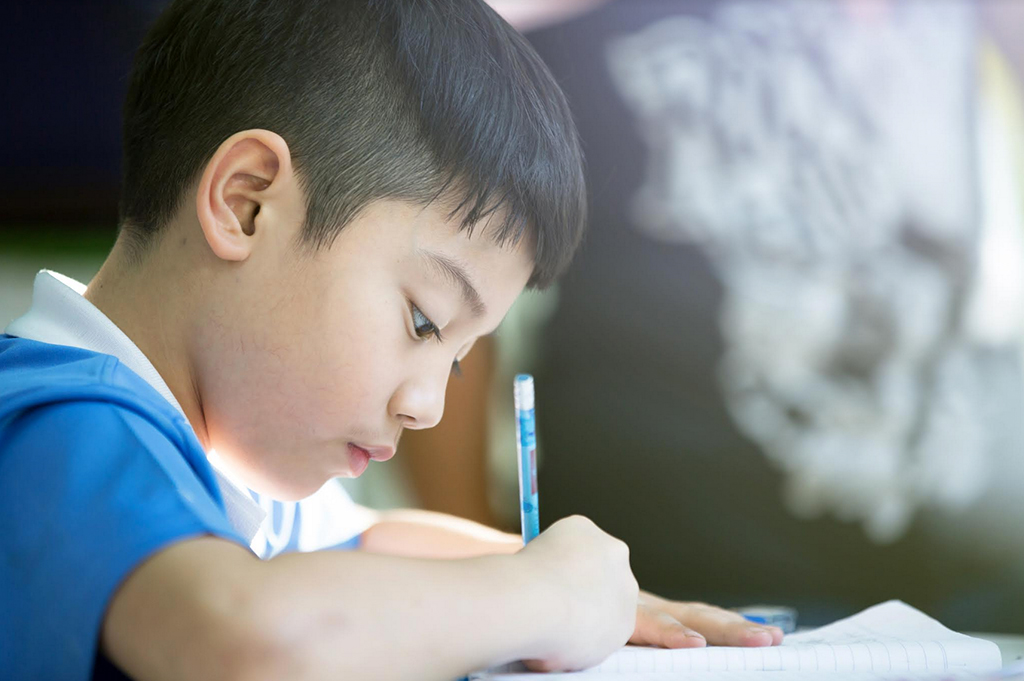影響孩子近視的10項危險因子
by 孫涵瑛 中山醫學大學視光學系副教授

近年來,學童近視的發生率越來越高,尤其在亞洲國家中更高達90%以上。俄羅斯研究發現學齡前孩童已有2.4%近視,而5年級時增加到19.7%(增加8倍)。這些數字代表一些警訊,WHO「2020失明與失聰的控制及預防」計畫中更指出近視為前五大需要積極預防避免的疾病。科學家致力尋找和近視發生相關的危險因子,下列我們整理和近視相關的危險因子給大家參考:
1.遺傳:
孩童近視機率為28%左右;但若雙親近視者機率增加至85%。由此推論,遺傳是近視發生的危險因子,父母中有一位有近視的孩童會比父母皆沒有近視的孩童罹患近視的機率增加1.5-3倍。
2.種族:
東亞地區的近視率偏高,尤其是華人比起歐洲(高加索人)或其他種族都高的許多。
3.環境、教育和都市化:
尼泊爾研究中發現居住在城市(21.7%)近視率高於居住在偏鄉地區(2.9%)。高近視率可能是生態上的轉變,教育程度與社會地位高、經濟能力以及城市化都有相關。環境因素造成很多直接和間接影響,不同種族居住同一環境顯現接近的近視盛行率,這也說明環境影響。
4.戶外時間、近距離工作時間:
孩童適當的戶外時間可以減少近視發生機率,重點在如何讓孩童在戶外時間與近距離工作取得平衡。12歲的孩童每天戶外時間少於1.6小時,又加上學校外3小時額外學習時間,會比每天戶外時間超過2.8小時,學習時間低於2小時者近視率高出2-3倍。戶外體能運動每周7-14小時則可以預防近視的發生。
12-13歲孩童閱讀書籍的距離少於29公分會增加2.5倍近視風險,閱讀時間超過30分鐘會增加1.5倍近視風險16。6歲孩童近距離活動超過一小時/天會增加1.26倍近視的機率。再加上其他因素,孩童教育功課上多花許多時間、閱讀時間增長、父母又近視以及戶外運動時間縮短,就會加成近視發生機率;又或者他們一天超過兩個小時在看電視或玩電腦遊戲、手機遊戲,都會增加近視的機率。父母較關心孩童視覺活動的孩童,以及孩童有充足睡眠時間、注意寫功課的姿勢等等,近視率降低2倍。父母越早開始注意這些危險因子,他們的孩童將會有較好視覺狀態與功能。
5.屈光度:
6歲孩童散瞳後的等價球面度若低於遠視0.75 D,未來發生近視有很高的預測性(95%)。遠視保留度持續越久,孩童越不易近視。
6.眼軸長度:
正常視覺基因背景下,6歲時眼軸大於23.5 mm 和近視有很高的相關性。在13-14歲時,眼軸長超過24.33 mm者有很高的近視風險。
7.周邊屈光度和眼軸長:
近視發生前2-5年時,相對周邊遠視屈光狀態被認為是預測是否近視的因子。研究7-11歲孩童追蹤視網膜中心小窩至周邊20度形狀,發現近視的發生與視網膜型態變化有關。
8.調節:
調節反應較差被認為是預測近視的獨立危險因子。特別要注意的是當孩童做近距離工作時,頭部姿勢較彎曲或相對調節力下降,近視的發生率都會增加。
9.假性近視:
假性近視是一種症狀,可視為近視預測因子之一。假性近視者的屈光度檢測時為近視,但散瞳驗光後會呈現正視眼甚至遠視。A.I. Dashevskiy (1988) 提出假性近視是近視的前期。假性近視者有3.03倍的風險變為近視,而已經近視的孩童有77.8%曾出現假性近視的狀況
10.眼位、調節與調節性內聚的關係:
孩童內斜眼位大於3個稜鏡度可能就是導致近視的危險因子
近視已經變成這個世代中平常的事,但不斷升高的近視率與高度近視率,將會影響未來孩童的學習以及形成全民醫藥衛生問題。遺傳因子或許我們已無法改變,但可以從環境與行為因子下手,包括:戶外活動時間、近距離視覺工作、早期偵測視覺指標等等。直接或間接減少危險因子地發生對於近視的預防非常重要,也希望大家一同做起,早期預防勝於後期治療。
參考資料:
- Wojciechowski R. Nature and nurture: the complex genetics of myopia and refractive error. Clin. Genet, 2011, 79. 301–320.
- Proskurina O.V. et al. Prevalence of Myopia in Schoolchildren in Some Regions of Russia. The Ophthalmology in Russia, 2018, 15. 348–353 (in Russian).
- Foster P.J., Jiang Y. Epidemiology of myopia. Eye (Lond), 2014, 28. 202–208.
- Morgan I.G. et al. The epidemics of myopia: Aetiology and prevention. Prog. Retin. Eye Res, 2018, 62. 134–149.
- Wu M.M., Edwards M.H. The effect of having myopic parents: an analysis of myopia in three generations. Optom. Vis Sci, 1999, 76. 387–392.
- Jones-Jordan L.A. et al. Early childhood refractive error and parental history of myopia as predictors of myopia. Invest. Ophthalmol. Vis. Sci, 2010, 51. 115–121.
- Zadnik K. et al. The effect of parental history of myopia on children's eye size. JAMA, 1994, 271. 1323–1327.
- Mutti D.O. et al. Refractive error, axial length, and relative peripheral refractive error before and after the onset of myopia. Invest. Ophthalmol. Vis. Sci, 2007, 48. 2510–2519.
- Garner L.F. et al. Prevalence of myopia in Sherpa and Tibetan children in Nepal. Optom. Vis. Sci, 1999, 76. 282–285.
- Zhou S. et al. Association between parents’ attitudes and behaviors toward children's visual care and myopia risk in school-aged children (meta-analis). Medicine, 2017, 96. e9270.
- Avetisov E.S. Blizorukost': monografiya [Myopia: a monograph]. Moscow, Meditsina Publ., 1999,186 p. (in Russian).
- Gray C. et al. What is the relationship between outdoor time and physical activity, sedentary behaviour, and physical fitness in children? A systematic review. Int. J. Environ Res. Public Health, 2015, 12. 6455–6474.
- Rose K.A. et al. Outdoor activity reduces the prevalence of myopia in children. Ophthalmogy, 2008, 115. 1279–1285.
- Saxena R. et al. Prevalence of myopia and its risk factors in urban school children in Delhi: the North India Myopia Study (NIM Study). PLoS One, 2015, 10. e0117349.
- Rose K.A. et al. Myopia lifestyle and schooling in students of Chinese ethnicity in Singapore and Sydney. Arch. Ophthalmol, 2008, 126. 527–530.
- Huang H.M. et al. The Association between near work activities and myopia in children – a systematic review and meta-analysis. PLoS ONE, 2015, 10. e0140419.
- Holton V. et al. A nationwide study of myopia in taiwanese school children: family, activity, and school-related factors. J. Sch. Nurs, 2019, 13, p. 1059840519850619.
- Mutti D.O. et al. Parental myopia, near work, school achievement, and children's refractive error. Invest. Ophthalmol. Vis. Sci., 2002,43. 3633–3640.
- Zadnik K. et al. Prediction of juvenile-onset myopia. JAMA Ophthalmol, 2015, 133. 683–689.
- He X. et al. Axial length/corneal radius ratio: association with refractive state and role on myopia detection combined with visual acuity in Chinese schoolchildren. PLoS One, 2015, 10. e0111766.
- Schmid G.F. Association between retinal steepness and central myopic shift in children. Opt. Vis. Sci, 2011, 88. 684–690.
- Mutti D.O. et al. Accommodative lag before and after the onset of myopia. Invest. Ophthalmol Vis Sci, 2006, 47. 837–846.
- Charman W.N. Near vision, lags of accommodation and myopia. Ophthalmic Physiol. Opt., 1999, 19. 126–133.
- Goss D.A. et al. Clinical findings before the onset of myopia in youth: 2. Zone of clear single binocular vision. Optom. Vis. Sci, 1996, 73. 263–268.
- Dashevskii A.I. et al. Myopia and pseudomyopia: development and prevention. Vestnik oftal'mologii, 1988, 3, 13.
- Mutti D.O. et al. The response AC/A ratio before and after the onset of myopia. Invest. Ophthalmol. Vis. Sci, 2017, 58. 1594–1602.
專為孩子設計的全方位近視管理 解決方案 >

